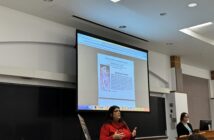In an age when TikTok trends have the power to influence political engagement and Instagram feeds serve as a platform for sharing opinions, adolescents encounter politics differently than previous generations.
As the election season comes to a close, the wide variety of outlets adolescents use to learn about politics draws attention to the different ways young people develop their understanding of political issues and whether they can think critically about the (mis)information they encounter online.
The combination of social media content, driven by algorithms programmed to drive emotional engagement and a lack of political discussion in schools could negatively affect future elections, Amy Jordan, the chair of journalism and media studies at Rutgers University, said.
She said this could threaten our democracy as a whole.
Jordan, whose research focuses on the role of media in the lives of children and adolescents, believes the years between the ages of 10 to 13 are important in the development of a person’s political beliefs.
With an increasingly polarized and fractured media environment and an influx of emotional appeals and political misinformation, Jordan said children and teens today have to develop greater skepticism and media literacy than prior generations.
“In previous generations, adolescence was a time of exploration, and you didn’t feel necessarily judged by your peers or the world around you if you stated a view that you were just exploring,” Jordan said.
She said she’s concerned that contemporary media may breed cynicism.
“I worry that children are going to see an election process that is messier than one that would hold their confidence in the democratic process,” Jordan said.
In addition to social media, many other forms of campaigning reach children, such as television and YouTube commercials, billboards, and radio and streaming audio ads. In 1949, amid outcry around false reports and inflammatory news on the radio, the United States Federal Communications Commission introduced the fairness doctrine, which required holders of broadcast licenses to provide important public information from both ends of the spectrum. However, in 1987, the FCC abolished this doctrine, allowing for the emergence of a more polarized media system over time.
Bruce Hardy, media and communications professor at Temple University, said this marked the start of the U.S. becoming as divided as it is today.
He said the increase in deregulated media on both ends of the political spectrum has led to more divisive rhetoric.
“It’s not like we love our party more,” Hardy said. “We’ve loved them all the same. It’s that we hate the out-group more.”
Social media has had both positive and negative impacts on political communication, Hardy said It provides a space for people to freely voice their opinions, but it can also give power to the wrong people and lead to hateful rhetoric and mass-scale information manipulation.
Navigating this maze of information, with blurred lines between fact and opinion can be difficult for adolescents. In academic literature, teaching media literacy to students of all ages is often found to be an effective strategy, and according to Common Sense, this can be done by using critical thinking strategies, addressing bias, being skeptical of social media sources and acknowledging AI influence.
Joseph Anthes, the supervisor of related arts and social studies for public schools in the Bethlehem area, said he believes in the importance of educators’ role in promoting media literacy strongly.
“We’re working on building the understanding of what are those systems that our government is built upon,” said Anthes. “Our job is not to impart our belief systems on our kids, and we also want to respect individuals and families’ political beliefs.”
Anthes, in his eighth year in the Bethlehem Area School District, said he has noticed a shift in politics toward increased divisiveness.
He said he believes productive civil discourse is an important topic that needs more coverage in the classroom. However, Anthes also noted that it all starts with adults.
“If you’re a 10-year-old child, now in fourth grade, you have grown up with a very divisive adult climate,” he said. “I don’t know if we as adults and what they see in the media is always modeling the type of discourse that we would like them to have, which is really ironic.”
When it comes time to teach about these topics, Anthes said it’s important that educators go in without any predetermined bias.
He explained that there is a state standard that requires election processes to be taught in classes but said more context than the written curriculum is sometimes needed.
In the past several years, there’s been a shift of focus on social-emotional learning and overall wellness being taught in classrooms, which Anthes said is very closely related to the best way to teach students about politics and civic engagement.
“In the standards for social-emotional learning, there (are) pieces about cooperation, about personal responsibility — things that can play very much into what it means to be a citizen,” he said.






Comment policy
Comments posted to The Brown and White website are reviewed by a moderator before being approved. Incendiary speech or harassing language, including comments targeted at individuals, may be deemed unacceptable and not published. Spam and other soliciting will also be declined.
The Brown and White also reserves the right to not publish entirely anonymous comments.